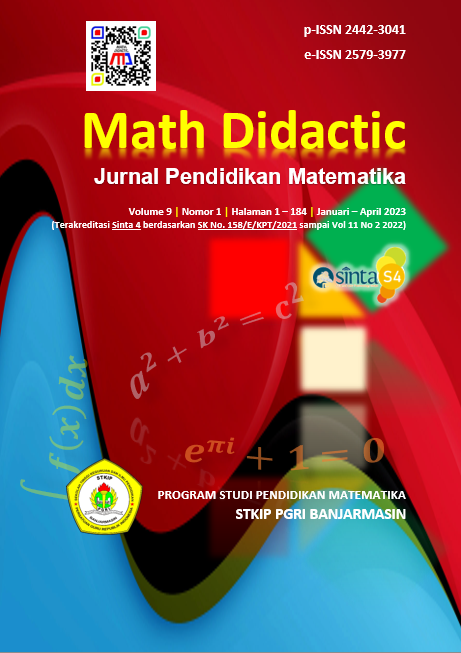Identification of critical thinking skills in mathematics students of class VIII SMPN 61 West Jakarta
Identifikasi kemampuan berpikir kritis matematika siswa kelas VIII SMPN 61 Jakarta Barat
Abstrak
Critical thinking skill is one of the highest levels of cognitive abilities. This competence is needed to support students in thinking and resolving problems in daily life. Initial identification requires students' critical thinking ability to be a guide in designing a model or strategy of learning. The purpose of this study is to know and describe students' critical thinking ability to solve mathematical problems in the circular matter, with a qualitative approach. The data-gathering technique uses a critical thinking skill test for as many as three problems with a circle matter. Further interviews are conducted to strengthen students' critical thinking abilities. Research instruments are praised on 34 students living in the viii class 61 Jakarta. The selection of the subject of research is based on the results of researchers' observations on the issues in the field that were discussed with the teacher of the subject. The results of the student's work are studied by pointing to critical thinking ability indicators that researchers have established - interpretation, analysis, evaluation, and inference. Research shows that students' critical mathematical thinking ability is at low criteria, where an interpretation attainment indicator is 38.24%; Analysis of 49.02%; evaluation of 47.3%; And inference at 26.47%.
##plugins.generic.usageStats.downloads##
Referensi
Agnafia, D. N. (2019). Analisis Kemampuan Berpikir Kritis Siswa dalam Pembelajaran Biologi. Florea: Jurnal Biologi Dan Pembelajarannya, 6(1), 45. https://doi.org/10.25273/florea.v6i1.4369
As’ari, A. R., Ali, M. N., Basri, H., Kurniati, D., & Maharani, S. (2019). Mengembangkan HOTS (Higher Order Thinking Skills) melalui Matematika. Universitas Negeri Malang.
Ennis, R. H. (1996). Critical Thinking Dispositions: Their Nature and Assessability. Informal Logic, 18(2), 165–182. https://doi.org/10.22329/il.v18i2.2378
Facione, P. A. (2020). Critical Thinking : What It Is and Why It Counts. Insight Assessment, XXVII(1), 1–30. https://www.insightassessment.com/CT-Resources/Teaching-For-and-About-Critical-Thinking/Critical-Thinking-What-It-Is-and-Why-It-Counts/Critical-Thinking-What-It-Is-and-Why-It-Counts-PDF
Fisher, A. (2009). Berpikir Kritis: Sebuah Pengantar. (Vol. 1). Erlangga.
Herdiman, I., Nurismadanti, I. F., Rengganis, P., & Maryani, N. (2018). Kemampuan Berpikir Kritis Matematik Siswa SMP pada Materi Lingkaran. Prisma, 7(1), 1. https://doi.org/10.35194/jp.v7i1.213
Karim, K., & Normaya, N. (2015). Kemampuan Berpikir Kritis Siswa dalam Pembelajaran dalam Pembelajaran Matematika dengan Menggunakan Model Jucama di Sekolah Menengah Pertama. EDU-MAT: Jurnal Pendidikan Matematika, 3(1). https://doi.org/10.20527/edumat.v3i1.634
Kemdikbud. (2013). Permendikbud No. 64 Tahun 2013 tentang Standar Isi Pendidikan Dasar dan Menengah. Kemdikbud. Kemdikbud., 1(2), 58–72.
Lestari, M. F., Dumeva Putri, A., & Wardani, A. K. (2019). Identifikasi Kemampuan Berpikir Kritis Siswa Kelas VIII Menggunakan Soal Pemecahan Masalah. JRPIPM, 2(2), 62–69. https://doi.org/https://doi.org/10.26740/jrpipm.v2n2.p62-69
Nuryanti, L., Zubaidah, S., & Diantoro, M. (2021). Analisis Kemampuan Berpikir Kritis Siswa SMP. Jurnal Pendidikan: Teori, Penelitian, Dan Pengembangan, 3(2), 155–158. https://doi.org/10.17977/jptpp.v6i3.14579
Parameswari, P., & Kurniyati, T. (2020). Kemampuan Berfikir Kritis Siswa Dalam Memecahkan Masalah Matematika. JPM : Jurnal Pendidikan Matematika, 6(2), 89. https://doi.org/10.33474/jpm.v6i2.6606
Putri, R. D., Yuanita, P., Kartini, K., & Roza, Y. (2022). Analysis of mathematical critical thinking ability of junior high school students in solving circle problem. Math Didactic: Jurnal Pendidikan Matematika, 8(3), 223–235. https://doi.org/10.33654/math.v8i3.1944
Rahardhian, A. (2022). Kajian Kemampuan Berpikir Kritis (Critical Thinking Skill) dari Sudut Pandang Filsafat. Jurnal Filsafat Indonesia, 5(2).
Rahimah, N. (2019). Profil Berpikir Kritis Siswa dalam Memecahkan Masalah Matematika Berdasarkan Kemampuan Matematika. LENTERA Jurnal Ilmiah Kependidikan, 14(1), 59–68. https://doi.org/https://doi.org/10.33654/jpl.v14i1.637
Rahmawati, S., & Masykuri, M. (2019). Seminar Nasional Pendidikan Sains. 173.
Sari, S. P., & Ariani, N. M. (2022). Pengembanan Soal pada Materi Lingkaran untuk Kemampuan Berpikir Kritis Matematis Siswa SMP. Jurnal Math-UMB.EDU, 9(1), 50–59. https://doi.org/10.36085/math-umb.edu.v9i1.2230
Septiani, T. (2018). Upaya Meningkatan Kemampuan Berpikir Kritis Siswa Menggunakan Model Pembelajaran Improve. AlphaMath : Journal of Mathematics Education, 4(1), 33. https://doi.org/10.30595/alphamath.v4i1.7353
Suryani, T., & Haryadi, R. (2022). Analisis Kemampuan Berpikir Kritis pada Materi Statistika Siswa Kelas VIII MTs Assalam Pontianak. Jurnal Prodi Pendidikan Matematika (JPMM), 4(1), 345–364.
Susandi, A. D. (2020). Identifikasi Kemampuan Berpikir Kritis dalam Memecahkan Masalah Matematika. SIGMA, 6(1), 26–41. https://doi.org/http://dx.doi.org/10.36513/sigma.v6i2.864
Watson, G., Glaser, E., & Psychological Corporation. (2002). Watson-Glaser critical thinking appraisal, UK edition : practice test. Psychological Corporation.






















